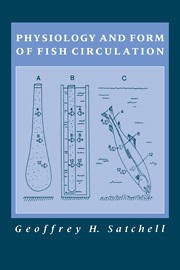Book contents
- Frontmatter
- Contents
- Preface
- 1 Introduction
- 2 The Heart
- 3 The peripheral circulation
- 4 The blood
- 5 Haemopoiesis and phagocytosis - the mononuclear phagocytic system
- 6 Circulation through special regions
- 7 Retial counter-current systems: flow–diffusion–concentration
- 8 Venous return and venous pumps
- 9 The autonomic nervous system
- 10 The response to exercise
- 11 The response to hypoxia
- 12 Myxine, a speculative conclusion
- References
- Appendix of popular and scientific names
- Index
5 - Haemopoiesis and phagocytosis - the mononuclear phagocytic system
Published online by Cambridge University Press: 05 February 2012
- Frontmatter
- Contents
- Preface
- 1 Introduction
- 2 The Heart
- 3 The peripheral circulation
- 4 The blood
- 5 Haemopoiesis and phagocytosis - the mononuclear phagocytic system
- 6 Circulation through special regions
- 7 Retial counter-current systems: flow–diffusion–concentration
- 8 Venous return and venous pumps
- 9 The autonomic nervous system
- 10 The response to exercise
- 11 The response to hypoxia
- 12 Myxine, a speculative conclusion
- References
- Appendix of popular and scientific names
- Index
Summary
When carbon particles are injected into the circulation of plaice kept at 5–10°C, 80% of them are removed from the blood within the first 30 min. Labelled red cells of turbot are cleared even more completely; 90% are removed from the blood within the half hour (Mac-Arthur et al. 1983). Avtalion (1981) reports that 99% of injected Staphylococcus aureus are cleared from the blood of snapper (Lutianus rivularis) in 30 min. In the spotted dogfish, injected carbon particles and latex beads disappear from the circulation within 12 h (Hunt and Rowley 1986). Examination shows that localized masses of vascular tissue in the gills, the kidney and the spleen are visibly blackened by the carbon particles. The cells involved in this clearance, and the organs in which they are located, have been the subject of much recent study and deserve our further attention. Some, but not all of these organs are able also to generate blood cells, one or another favouring erythropoiesis, granulopoiesis or lymphocytopoiesis. The two functions, of removing effete blood cells and replacing them with new ones, are so regulated as to maintain a volume of blood sufficient to fulfil its multiple transport and defensive roles set out in Chapter 4.
The phagocytic cells of the MPS system
The monocytes and thrombocytes in the circulating blood can, we have noted, phagocytize particles and bacteria, and may subsequently come to rest on the walls of blood vessels in organs such as the spleen, kidney and cavernous bodies. Thrombocytes appear to be more phagocytic in elasmobranchs than in teleosts and Ellis et al. (1976) report that in plaice they o not accumulate injected carbon particles.
- Type
- Chapter
- Information
- Physiology and Form of Fish Circulation , pp. 80 - 88Publisher: Cambridge University PressPrint publication year: 1991



